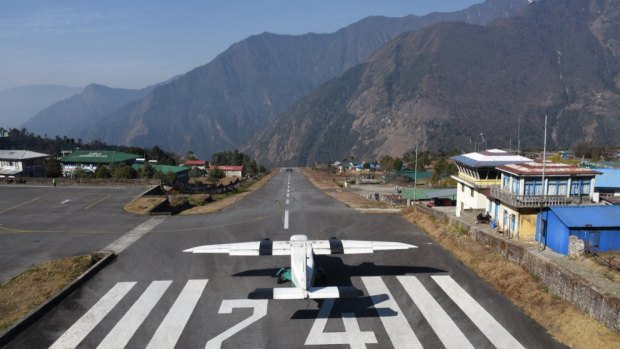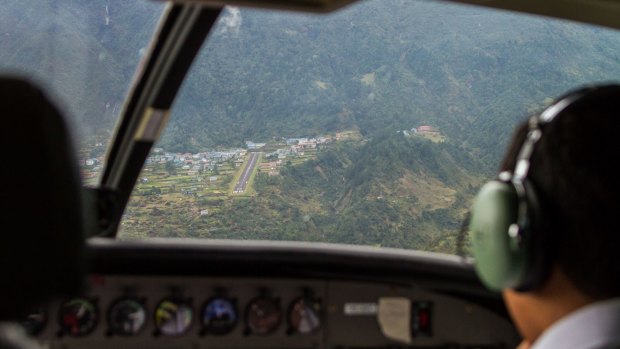This was published 5 years ago
Mt Everest airport: What makes Tenzing-Hillary Airport in Lukla, Nepal the world's most dangerous
By Hugh Morris

The tiny runway at Lukla.Credit: Shutterstock
The death of three people in a plane crash in Nepal has shone a spotlight once again on the airport used by hikers to reach the foothills of Mount Everest, and often labelled the most dangerous in the world.
On Saturday a light aircraft departing Lukla Airport veered off the runway and collided with a stationary helicopter, killing the pilot of the plane and two others standing nearby. An investigation into the accident has begun but officials have said the weather was good, and flights resumed later that day.
Lukla Airport, at 2,845m above sea level in eastern Nepal, is the gateway to the Everest region, with the growing popularity of trekking and climbing up and around the world's highest mountain leading to traffic at the tiny airport soaring in recent years.

A pilot's view of the approach to the airport.Credit: Alamy
But ease of access comes at a cost. The airport officially known as Tenzing-Hillary Airport, after Edmund Hillary, who supervised its construction in 1964, and Sherpa Tenzing Norgay, is infamous for its challenging operating conditions, in terms of terrain, weather and infrastructure. It was only paved in 2001.
"Airfields such as Lukla's are among the most remote and difficult to land on in the world," reads the Foreign Office (FCO) guidance on air travel in Nepal, "and are a challenge for even the most technically proficient pilots and well-maintained aircraft."
Two died at the airport in 2017 when a landing aircraft touched down short of the runway, clipping a tree in poor visibility, while 18 lost their lives in 2008 when a Twin Otter crashed on final approach in inclement weather, killing all on board except the captain. There have been at least five other accidents since the turn of the century.
Pilots arriving into Lukla must first navigate the vast peaks of the Himalayas, often cloaked in cloud, before lining up for an approach without the modern navigation systems used at most airports; arriving flight crew must know the terrain well.
They then have one of the shortest runways in the world to contend with, at just 1,729 feet long (Heathrow's shortest is 12,008 feet), which ends abruptly at a brick wall. With rising mountains all around there is little opportunity for an aborted landing - known as a go-around - so the pressure is on to get it right first time. The airport's altitude means the air is thinner so planes have no choice but to arrive faster, too.
For departures, flight crew must rumble down the steep tarmac (an 11 per cent gradient), knowing should they not be airborne by the end of it, a steep cliff awaits.
"It's high-stakes work and there's very little room for error," helicopter pilot Nischal KC told AFP. "Weather changes and the steep terrain sometimes make landing impossible."
Accordingly, pilots have to be certified especially to land at Lukla, having made at least 100 landings and take-offs on short runways and worked in such conditions for at least a year in Nepal. Before being allowed to fly solo, they must have completed 10 landings and take-offs in Lukla with a qualified instructor.
An indication of the type of weather pilots might expect at Tenzing-Hillary can be gleaned from a 2011 report of dense fog that grounded flights for a week, stranding thousands.
Though some managed to charter helicopters to make the 40-minute journey back to Kathmandu, where international flights operate, as many as 3,500 were left in the small mountain village, with some sleeping in tents on the airstrip. Others opted for the five-day trek to Jiri, and the nearest road.
Concerns regarding aviation safety in the country extend beyond the airport at Lukla, with the Foreign Office issuing a general warning regarding air travel in Nepal. It refers to four accidents since 2012, including the crash of a US Bangla Airlines flight last year, on landing at Kathmandu, which killed 51 passengers. All Nepalese airlines are banned from EU air space.
"The FCO can't offer advice on the safety of every individual airline, but the International Air Transport Association (IATA) publishes a list of registered airlines that have been audited and found to meet a number of operational safety standards and recommended practices," it says.
"This list is not exhaustive and the absence of an airline from this list doesn't necessarily mean that it is unsafe.
"A number of tour operators have decided to stop using certain airlines due to safety concerns. Specific safety concerns about Sita Air have led a number of tour operators to stop using them."
As it stands, three airlines serve Lukla: Tara Air, Sita Air and Summit Air, to which the plane involved in the weekend's crash belonged.
Despite the risk associated with flying in Lukla, the airport and its approach are said to be one of the most beautiful in the world, with flights taking in some of the most magnificent peaks of the Himalayas.
The Telegraph, London
See also: Most difficult destinations to travel to - but are totally worth it
See also: The world's riskiest travel destinations for 2019 named
Sign up for the Traveller Deals newsletter
Get exclusive travel deals delivered straight to your inbox. Sign up now.